What better use for a camera is there than taking photographs of people? They are the ultimate, endlessly fascinating subject, are they not? Which category is your favourite – sports, portrait, street? For me, it doesn’t get any better than photographing musicians.
As the ancient Greek aphorism goes: “Know thyself”. I believe I do. I am someone who loves organising snippets of information into overarching concepts. My aim is to bring order to chaos and extract penetrating insights from those elegant frameworks. That’s what I tell myself, anyway. This predisposition pervades both my professional life and personal interests. It is both a blessing and a curse, and well known to my friends and long-suffering family. When she was younger, my daughter (apparently a secret Latin scholar) listed me in her phone contacts as Daddius OCDius. For all I know, she still does.
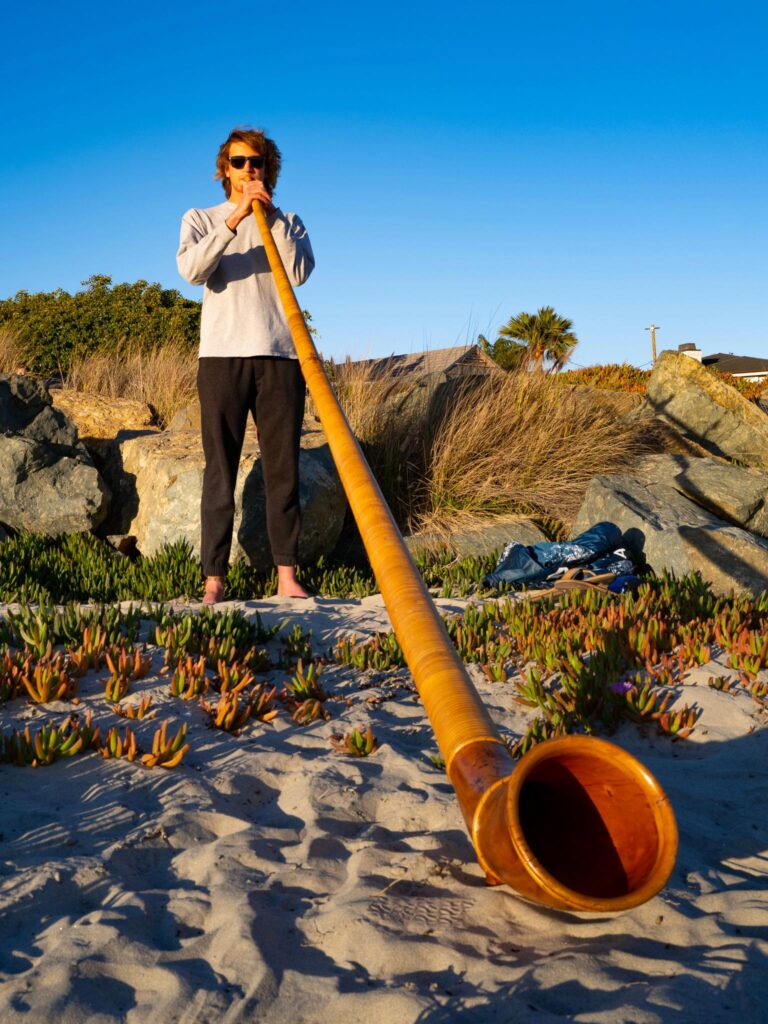
Naturally, I bring this outlook to my photography, exploring subjects that interest me – architecture, sculpture, or abstraction – somewhat obsessively. In contrast, I have not taken this approach to photographing people, a genre tackled from every conceivable angle by the world’s greatest photographers. It is also de rigueur for any self-respecting amateur. My reluctance to dive headlong into this field stems from a subconscious concern: not everyone wants to have their picture taken.
But, to my surprise, when perusing my collection of photographs at the start of the New Year, I realised there is one group of people where my obsessive tendency has been quietly at work.
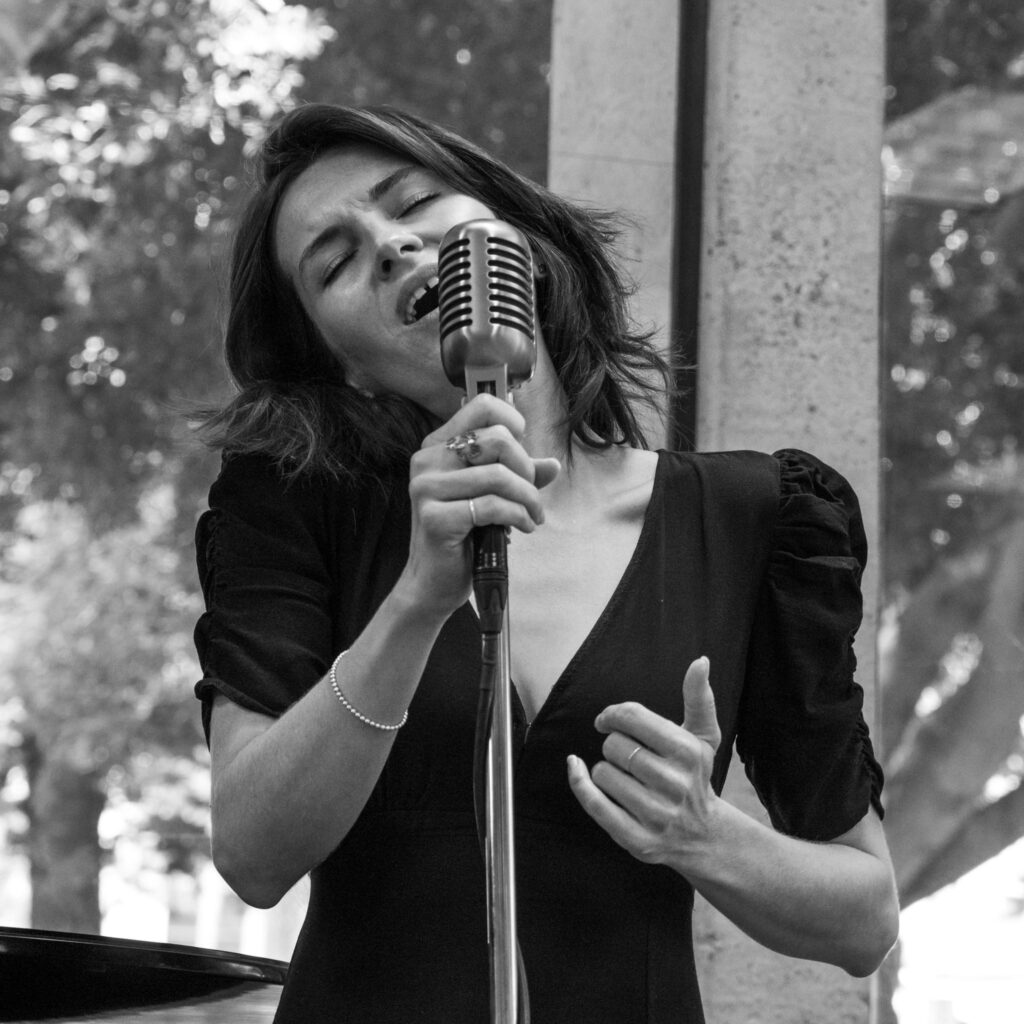
People with a purpose
Those people are musicians. If you’ve ever spent any time with one, you will know they are a remarkable breed.
Musicians are on a mission to bring their audience joy. They aim to transport them from an everyday world to a higher plane of human experience. These performers accomplish this through musical performances executed at the highest levels of virtuosity they can muster. Through thousands of hours of practice, they have become masters of their instruments, be they pianos, drum kits, or voices. They epitomise dedication and pursuit of excellence.
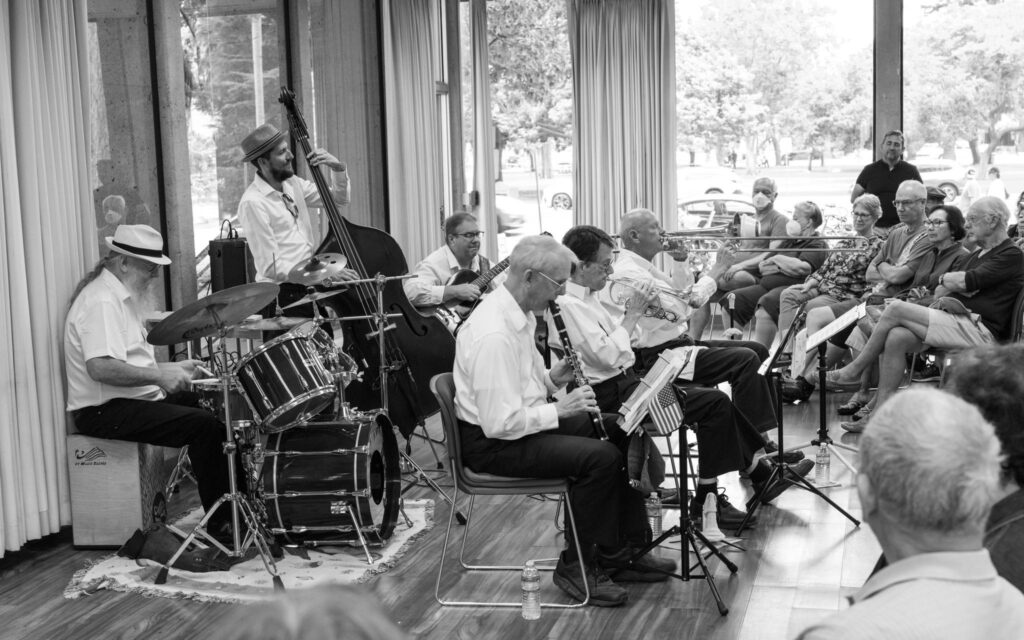
We might listen to their music on vinyl records, CDs, or streaming services. But from the perspective of either musician or audience, nothing beats a live performance. Musicians can be seen in person, engage directly with their fans, and be photographed by people like me.
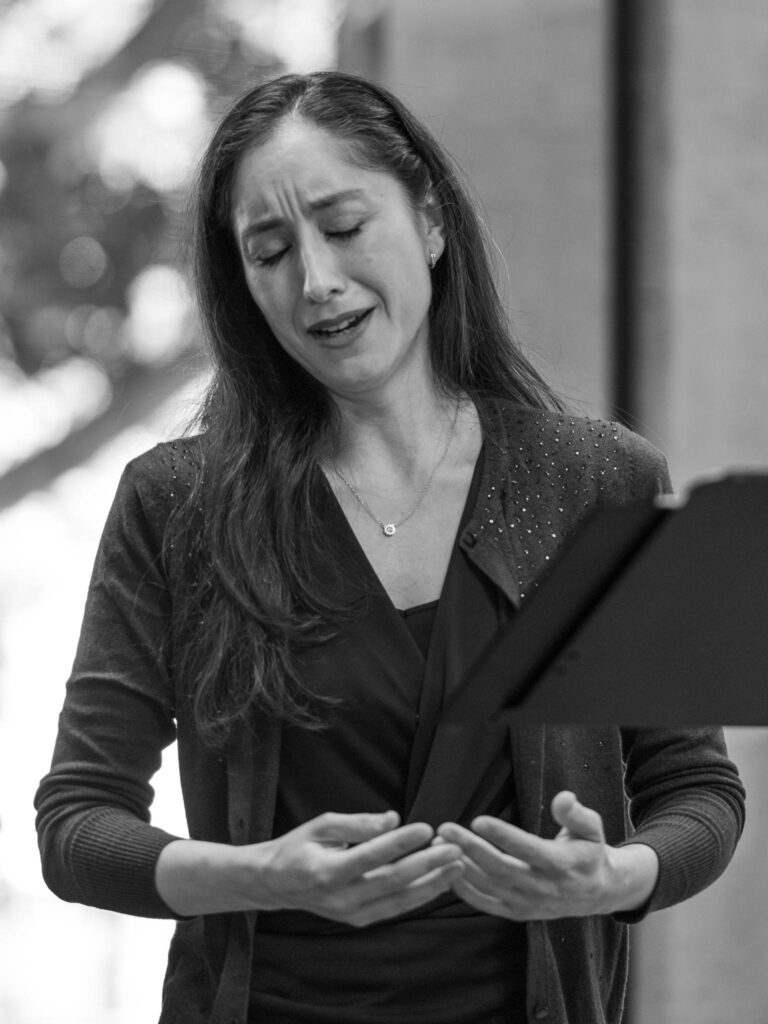
I have enjoyed live music my entire life, travelling to concerts since I was old enough to afford them and responsible enough to attend them. I even played a small part in the conception of a son who would grow up to be a professional musician. My musical tastes have evolved and matured over time. They encompass the orchestral suites of Georg Philipp Telemann and the jazz of Pat Metheny. Without realising it, those musical interests have now intersected with my enthusiasm for photography.
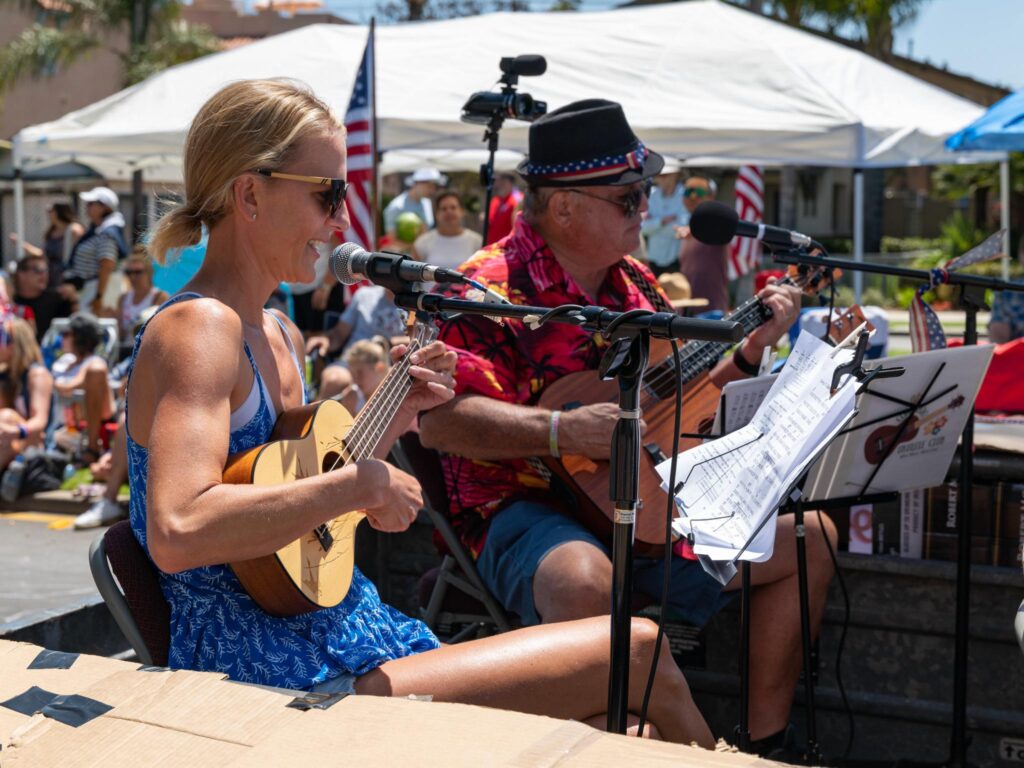
Live Music
Photographing musicians in performance hits the spot in so many ways: avoiding the squeamishness I usually feel pointing my camera at stranger; figuring out how to capture the special relationship between musician and instrument; dealing with the blur of motion as fingers fly over keys or arms swirl above drums; and enjoying that beautiful live soundtrack as I compose my shots.
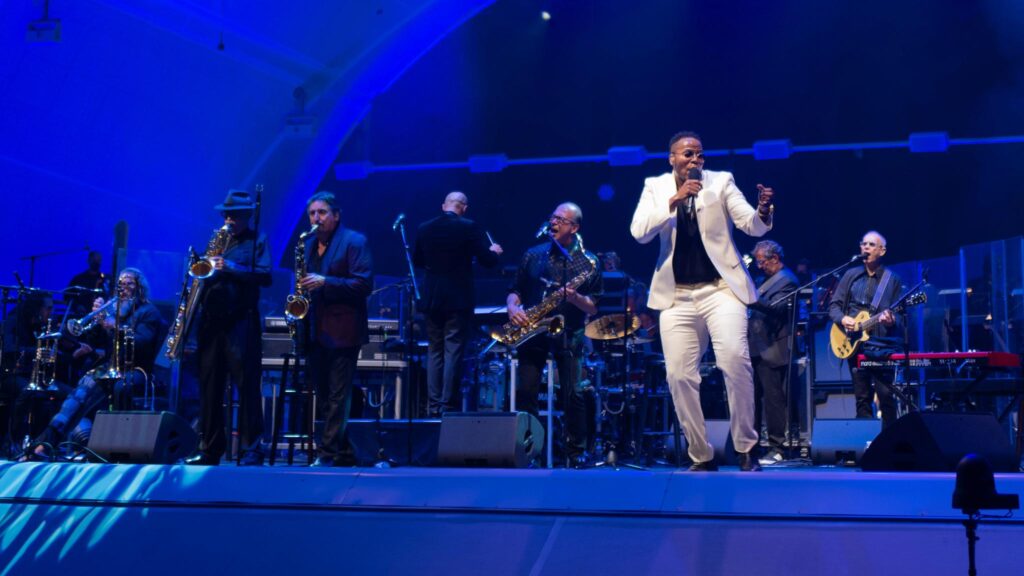
Music concerts vary in scale, from arena-level venues down to intimate club settings. Each presents unique opportunities and challenges for the amateur photographer. I am fortunate to live in a city where I can see musical performances at a world-class outdoor auditorium after a picturesque ferry ride, or at my local library after a five-minute walk.
If I arrive at one of those library concerts early I can grab a front-row seat as soon as the doors open. I can secure an unimpeded view of the musical performance. If that performance is a piano recital, the front-row seat affording a view along the keyboard is highly sought after, not just by photographers, but by piano teachers and their students; the competition is cut throat.
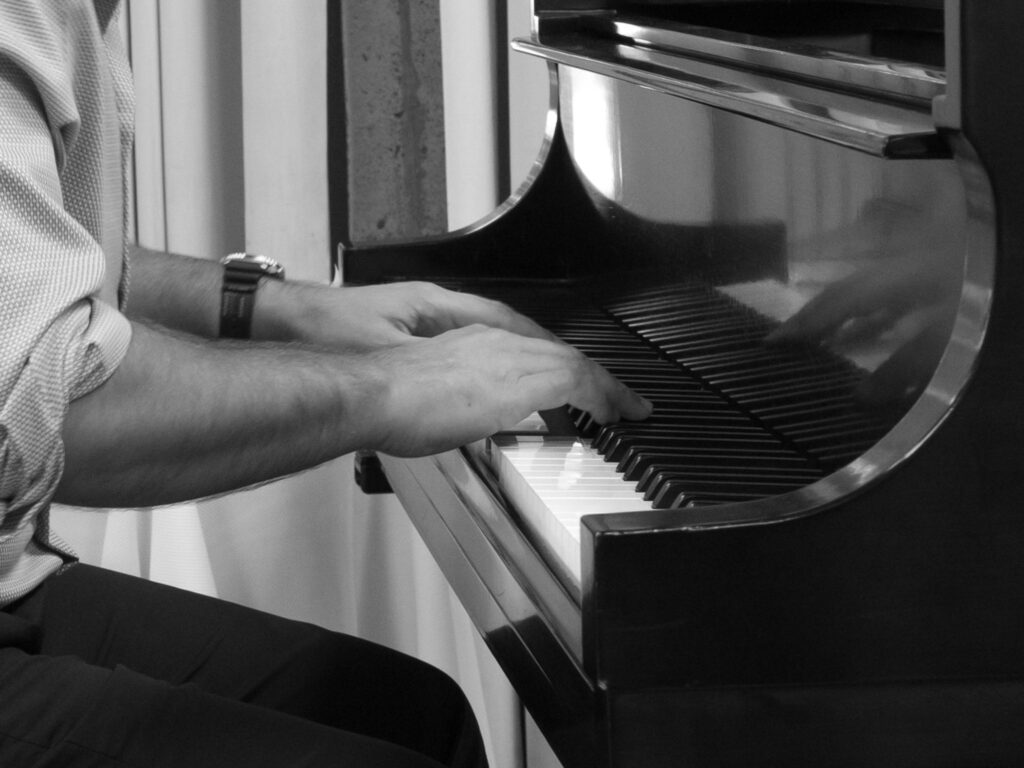
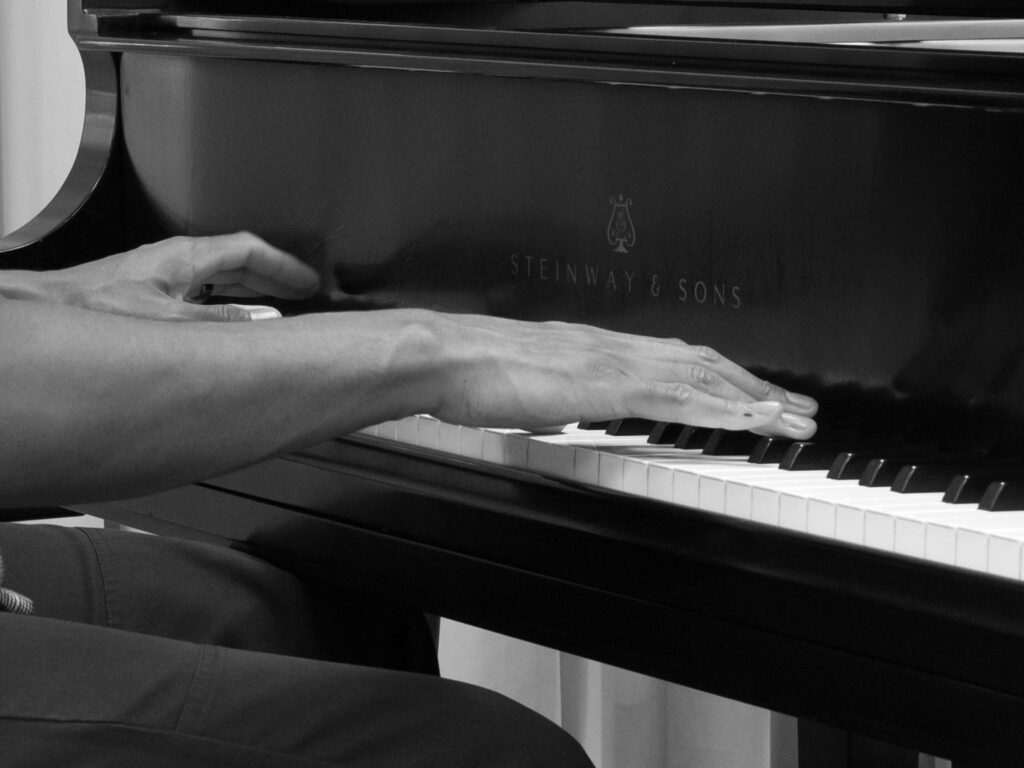

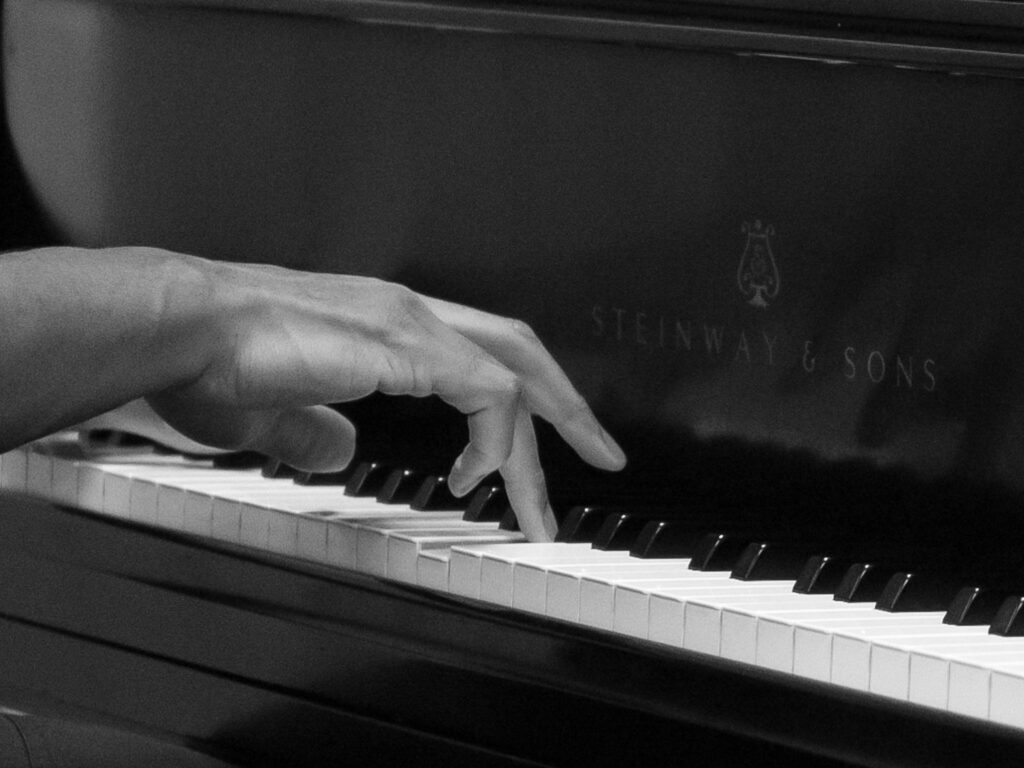
Despite my best efforts, I sometimes fail to secure this prime spot. Instead, I console myself with a photographic study of the pianist’s facial expressions as they immerse themselves in their music. Ah, well.
Photographing musicians on the hoof
I am less well placed to secure front-row seating at concerts across the Bay at the Shell open-air auditorium. The venue accommodates up to ten thousand people, with reserved seating throughout. Thankfully, there is no prohibition on loitering directly in front of the stage, viewing and photographing the artists close up, which I do.
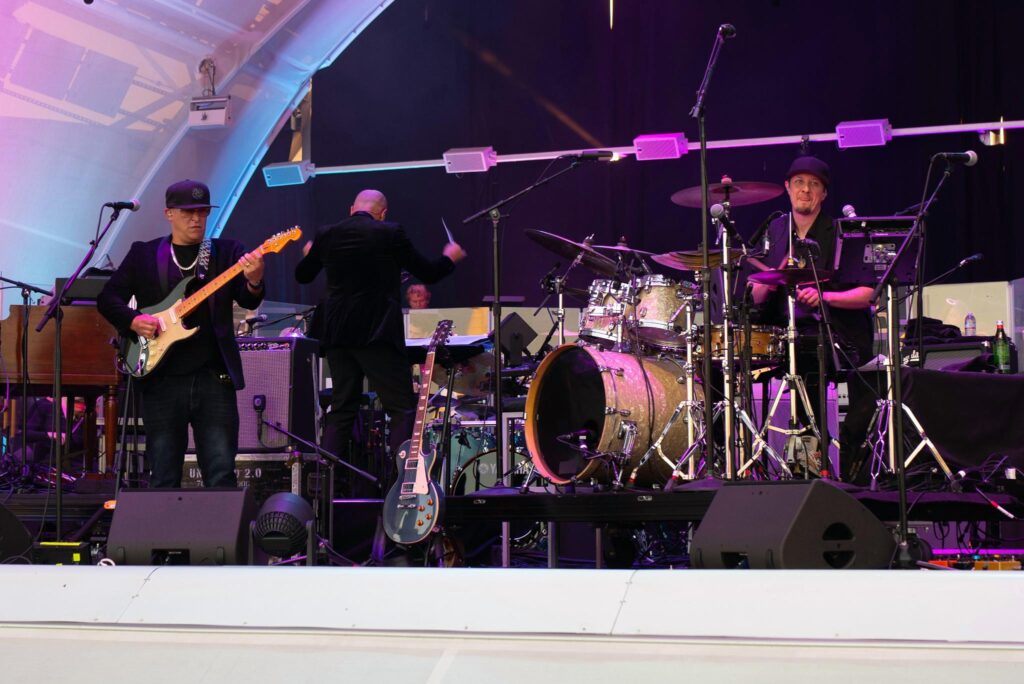
As well as at these two favourite venues, there are myriad other opportunities to photograph musicians in my neighbourhood. These include listening to street performers in downtown San Diego, attending summer open-air concerts in Coronado’s Spreckels Park, enjoying a band and a refreshing beverage at a local dive bar, or watching the annual Coronado July 4th Parade. This is a very musical part of the world.
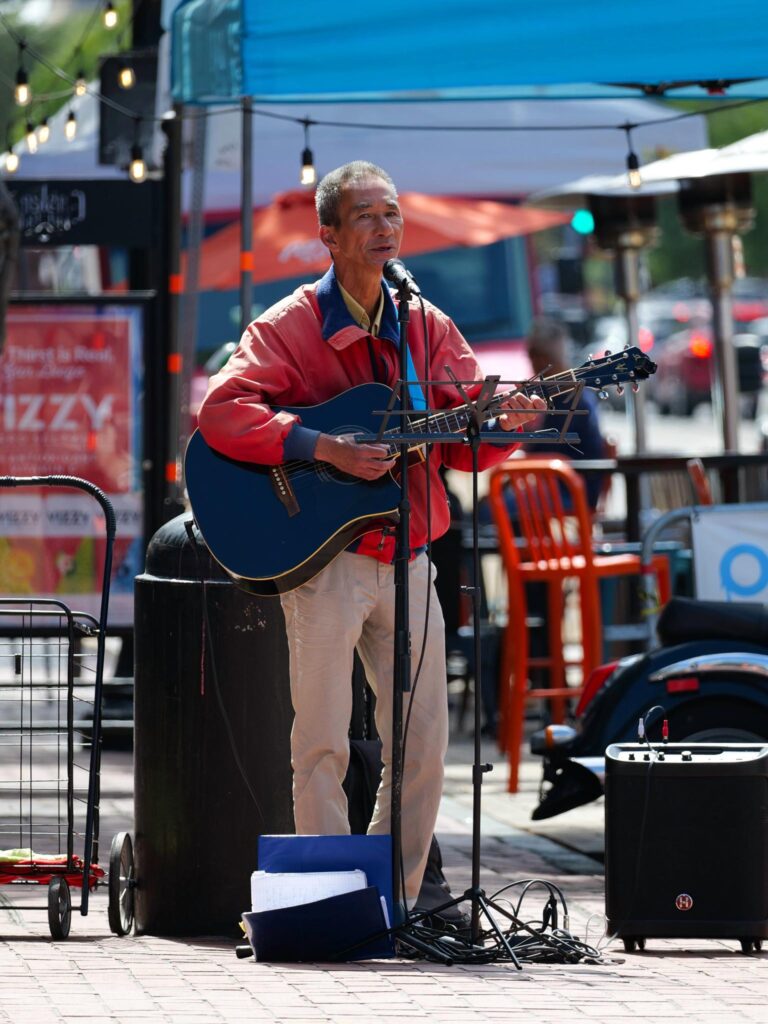

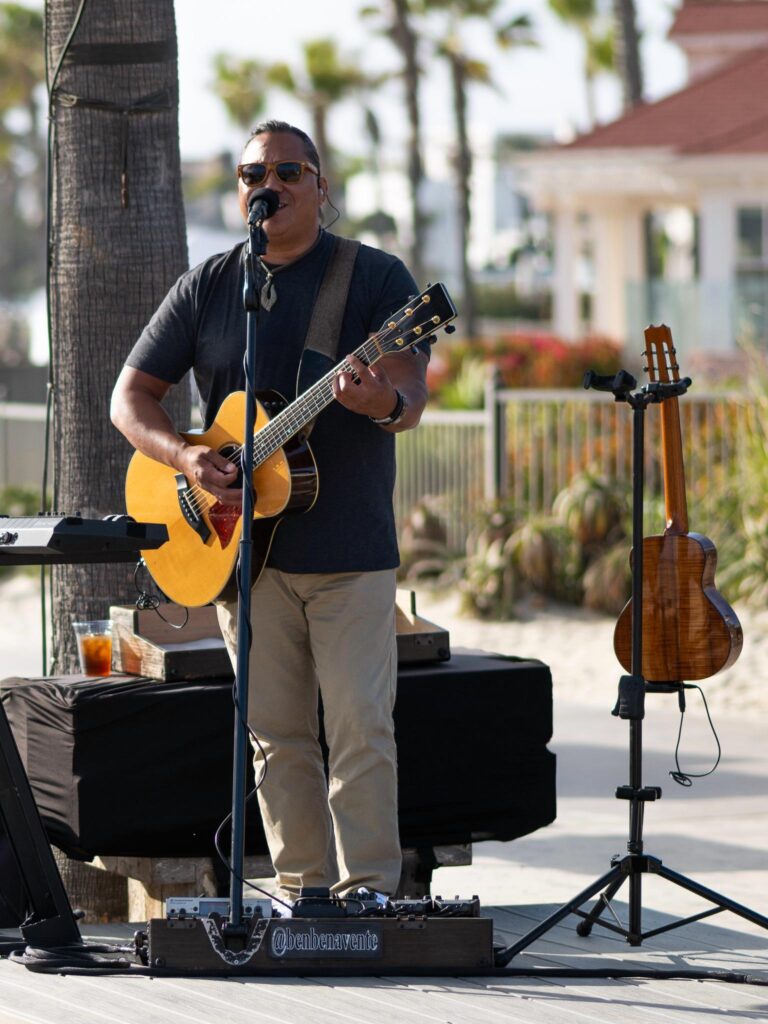
Camera gear for photographing musicians
I have experimented with a variety of camera and lens options in my photographic pursuit of musicians.
Sitting in the front row at library concerts, the Leica Q2, and more recently the Leica Q2 Monochrom, have proven versatile performers. Their 28mm field of view covering both individual artists and ensembles. Coupled with a Leica SL2 or Lumix S5, I have also experimented with a Leica 50mm f/2.0 APO. For close-up photos of expressive hands and contorted faces, a Lumix 85mm f/1.8 is terrific. The most flexible option for handling any scenario I might encounter is undoubtedly a Leica 24-70mm f/2.8 zoom.
Long lenses are forbidden at the Shell amphitheatre, and so I take along my Q2. I position myself as close to the stage as I can, and zoom in digitally during post-processing. I realize that some photographers look askance at digital zooming, but is is a handy strategy if you are unable to get close to your subject and have megapixels to spare. The photo of Elvis Costello is an absolutely massive crop of a shot taken wide open at f/1.7. You can see the progression in the images below. In the compressed final image we can still read ‘Fender’ on the headstock and see his name inlaid on the fretboard of his Jazzmaster. In a 1.3 Mb JPEG they are crystal clear; what a sensational camera this is.
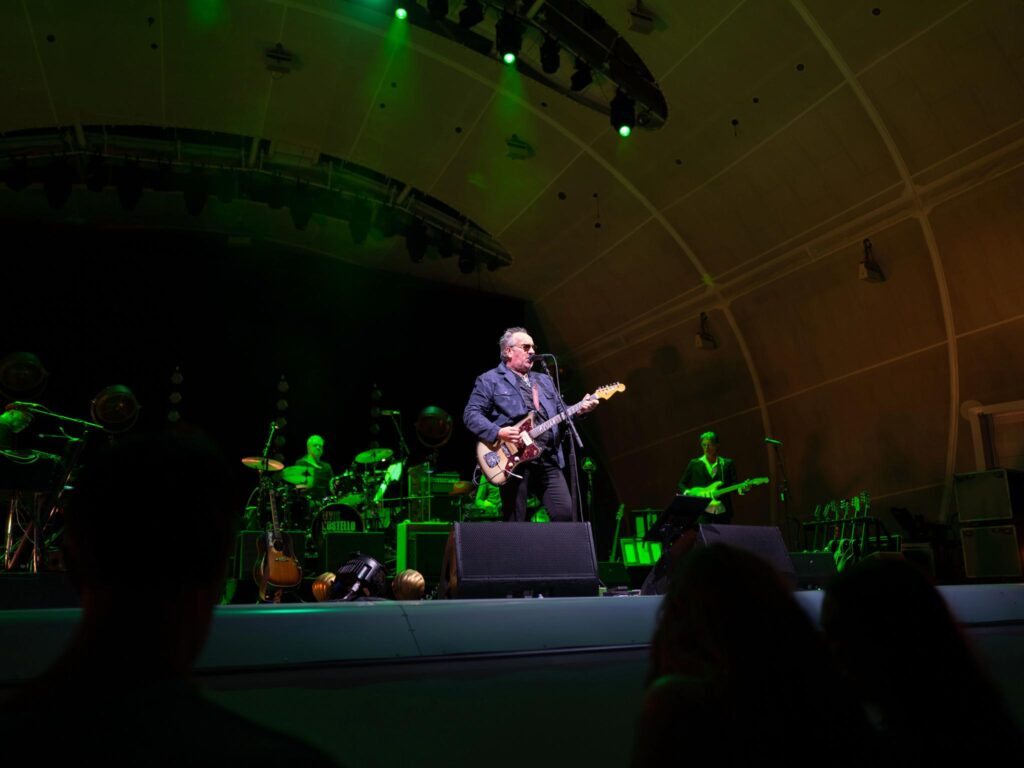

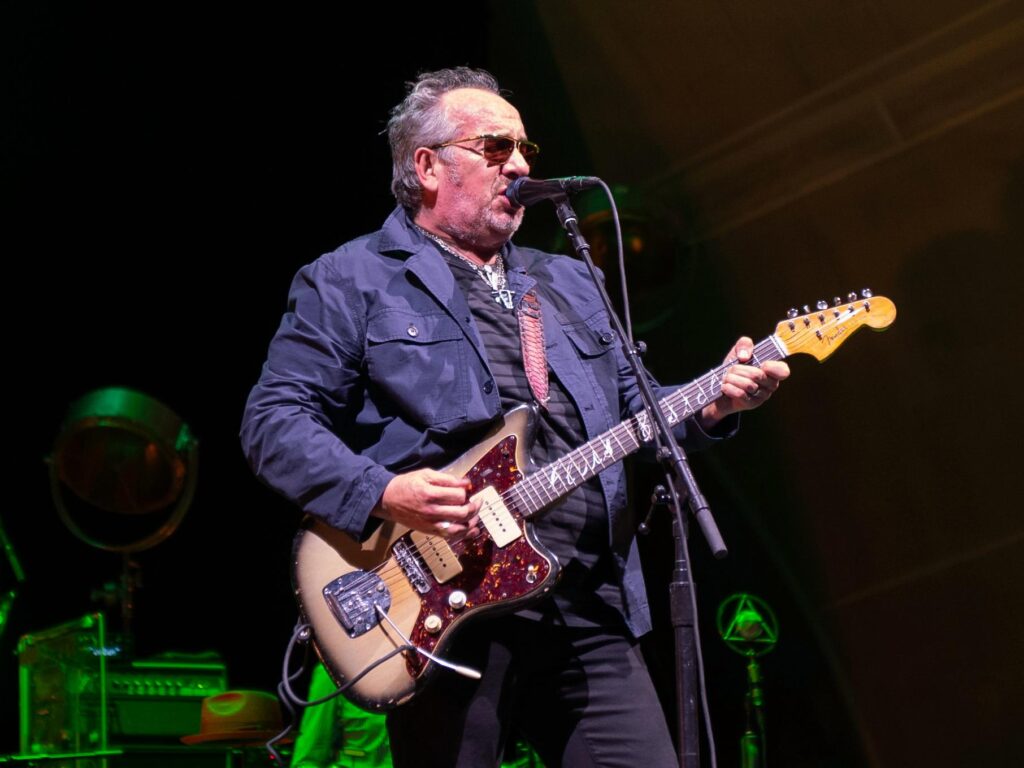
Challenges of photographing musicians
I encounter several recurrent issues while photographing musicians. Each is related to the challenge of achieving correct exposure whilst managing low light, motion, and depth of field. These are of course interdependent, ultimately governed by choice of aperture, shutter speed and ISO. But, solving this multi-parametric puzzle usually takes some experimentation.
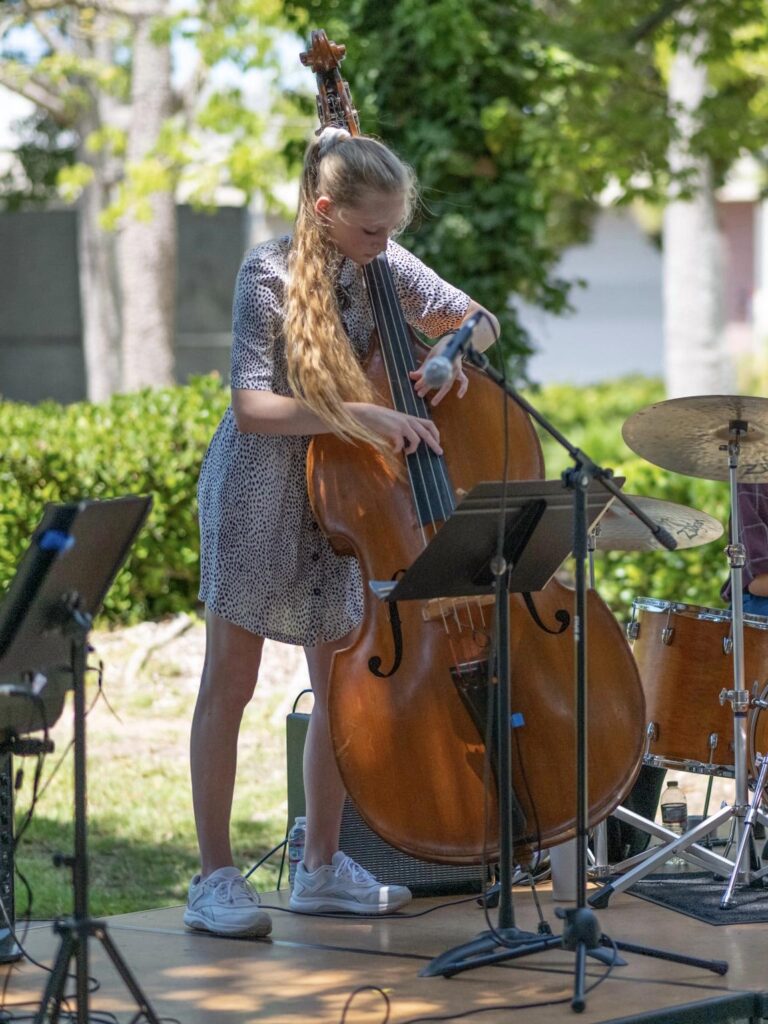
You would think a daytime outdoor performance represented the most straightforward scenario, where light is plentiful. Even then, shade from trees can complicate choice of camera settings, with the risk of blown highlights an ever-present threat.
Light is a scarce commodity in most indoor performance spaces unless using flash (which I do not) or the venue employs illumination from a professional lighting rig, which I rarely encounter. Fast lenses and wide-open apertures are the order of the day, with ISO level raised considerably. These days, I open aperture fully, select a fast shutter speed and let auto-ISO go where it pleases.
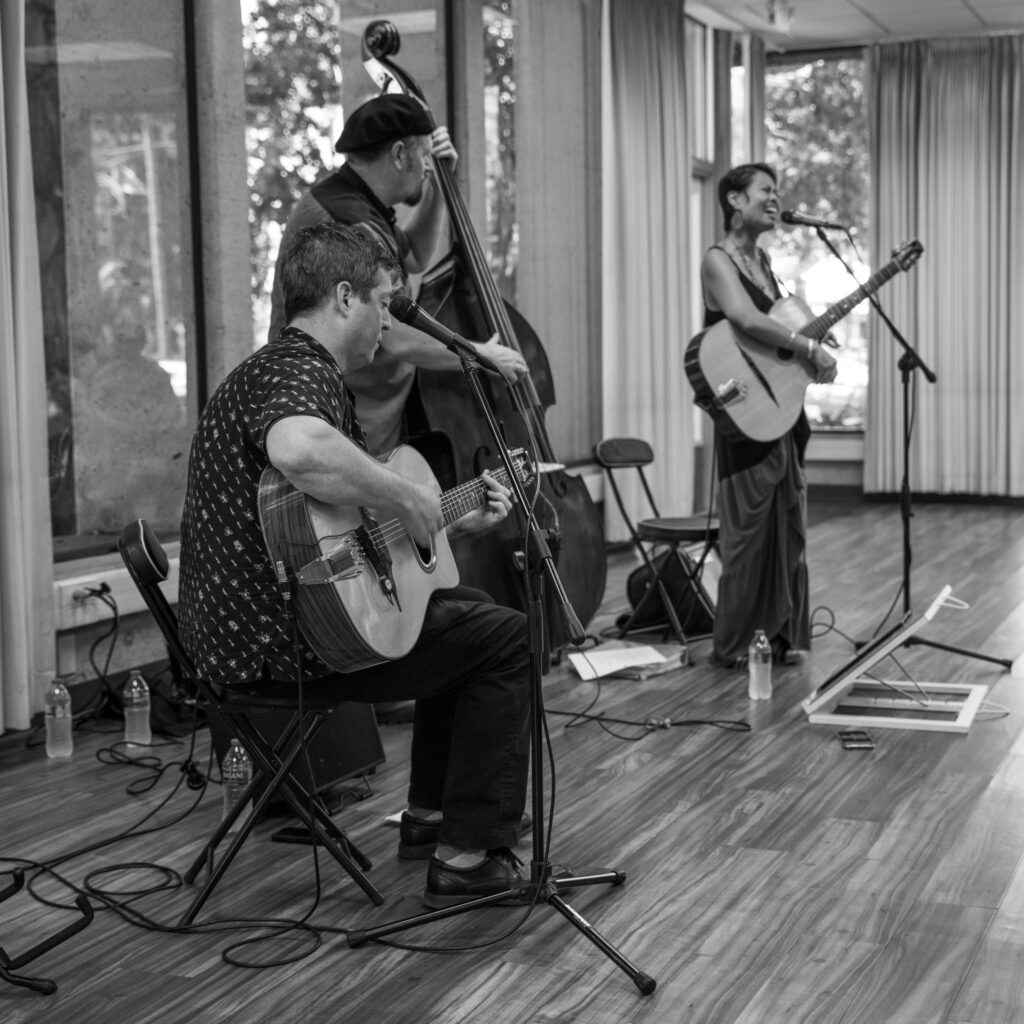
Daytime performances held indoors in venues with windows also make it difficult to manage the contrast between the performer and the bright background, sometimes visible through the window. I use exposure compensation, or make adjustments in Lightroom, but in general resign myself to some blown highlights.
Photographing musicians in depth
Shooting wide open at high ISO can generally solve the problem of motion blur associated with hands, cello bows, or drum sticks. However, it creates issues with depth of field. It turns out that the horizontal distance from the tip of a cello to the nose of a cellist means that only one can be in focus at f/1.7. I use manual focus most of the time, focusing on the artist or the instrument as I feel led.
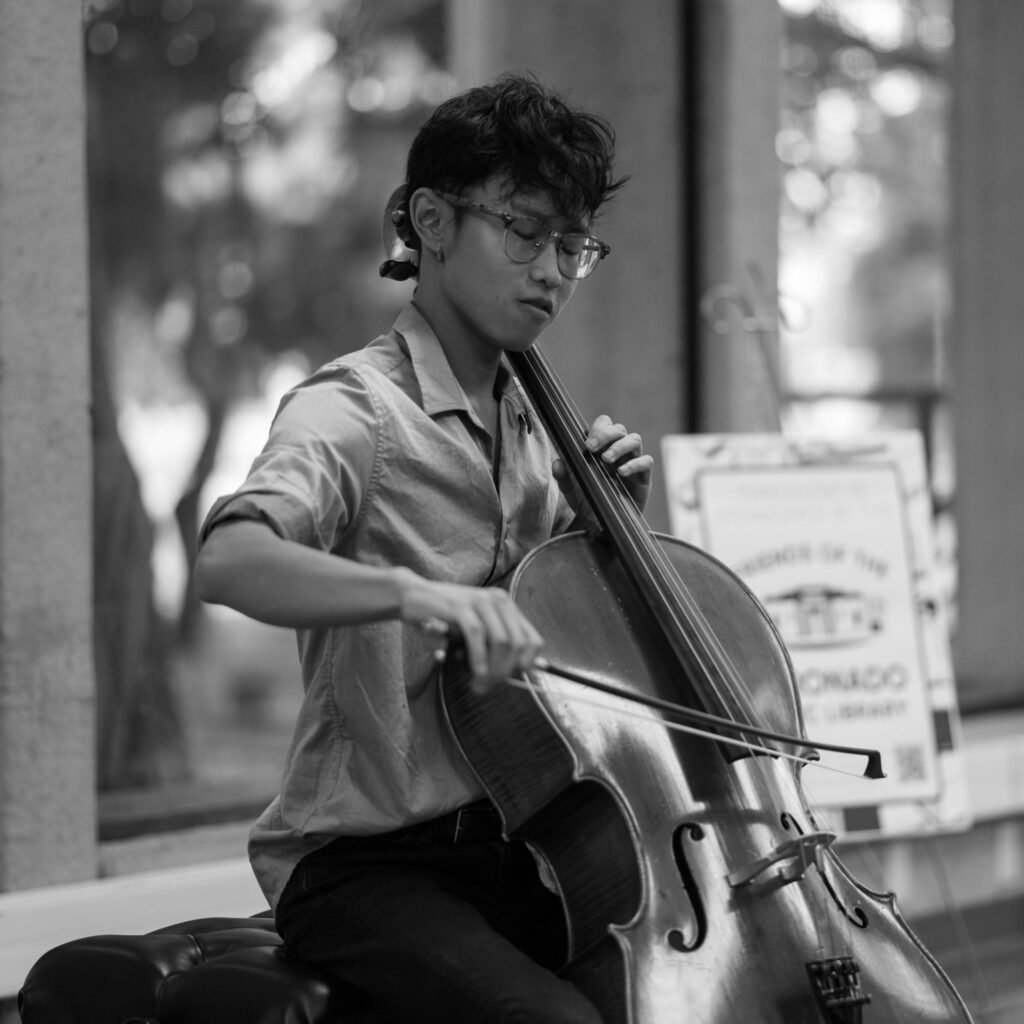
The most extreme depth of field challenge I have encountered was in photographing an alphorn player at the beach. Why there was an alphorn player on the beach in Southern California is another story, but he generously allowed me to photograph him from multiple vantage points while he practised. I took a pair of shots from a similar angle while prostrate in the sand. I shot the first closed down at f/11 (shown earlier) and the second wide open at f/1.7, focused on the mouth of the horn. Which do you prefer?
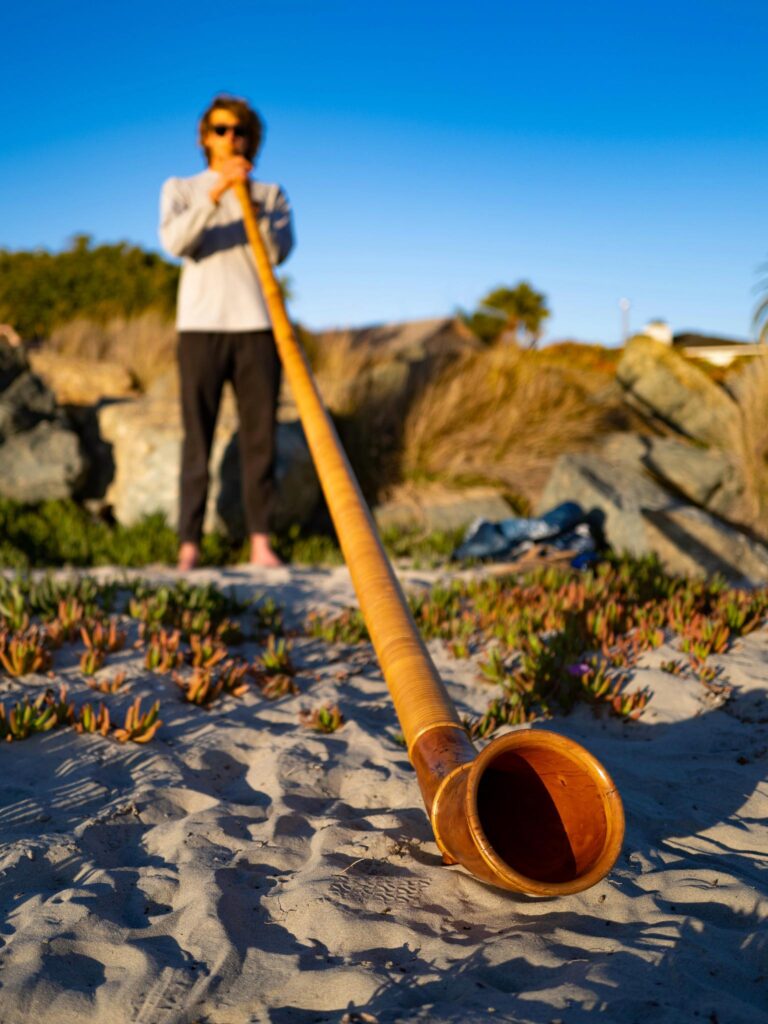
Photographing musicians in black and white
I photograph musicians in both colour and black & white. Why black and white? Indoors under fluorescent lights, colours tend to be drab, adding little to the image. I would rather place the emphasis on the musician’s posture, face, hands, fingers, and instrument. Monochrome images excel at directing the attention of the viewer to those features and shapes. In a professionally-staged setting, with a great light show, it would seem churlish to forgo the visual impact of a colour image. Sometimes, the light show even upstages the musicians.
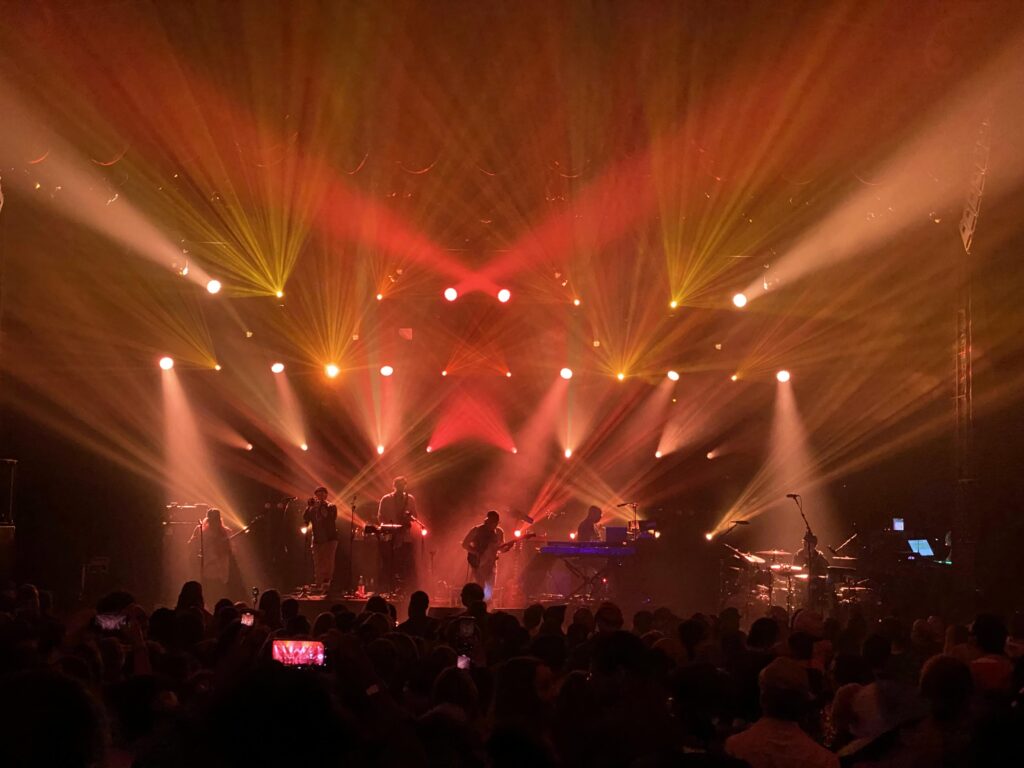
So, my rule of thumb for photographing musicians has become: large scale or outdoor settings – colour; indoor or small scale settings – black and white. But, when the situation requires it, I have no hesitation departing from this paradigm.
Photographing musical ensembles
I find it easier to photograph soloists rather than collections of musicians. I can focus, literally, on one individual and wait for the moment that epitomizes their performance. This might be when their aria reaches its climax or they become lost in the depths of the music. Ideally, these images provoke an emotional response on the part of the the viewer.
I find capturing comparable images of ensembles more challenging. Inevitably, with a wider field of view, each occupies a smaller space in the image, concealing their facial expressions. Sometimes, it is not even possible to include everyone in the photograph. The two approaches I have adopted to deal with this challenge have been either to accept that group shots inevitably lack visual impact, or pick out individual members of the ensemble worthy of closer attention.
At a recent, remarkable performance of Bachianas Brasileiras No. 1 for cello orchestra, by Heitor Villa-Lobos, I was able to capture the triumphant climax of the concert where the cellists raised their bows to the heavens. I consider this one of my more successful ensemble photos.
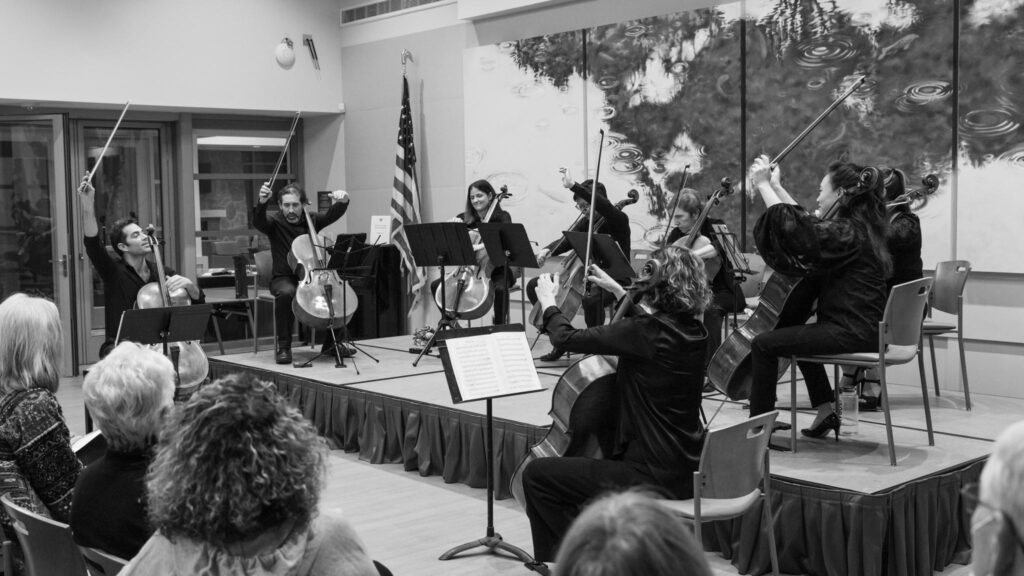
At the same concert, I was able to peek over the shoulder of a cellist as she read her score. Shooting with a portrait lens wide open nicely blurred the background while still revealing the instruments of her fellow cellists.
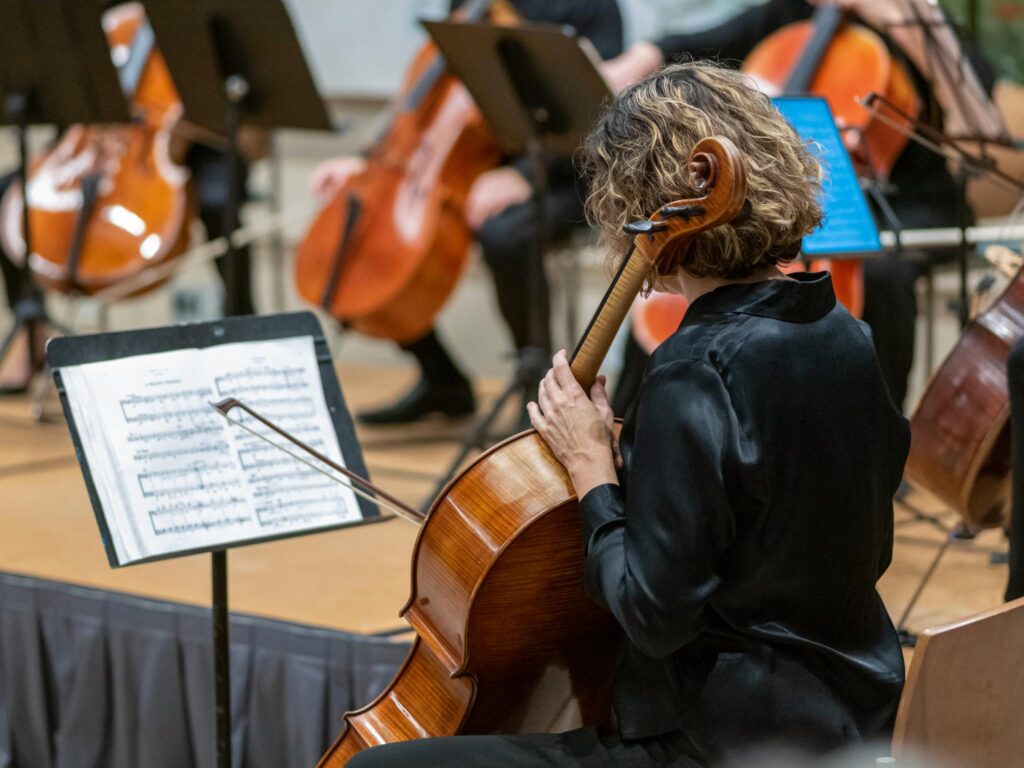
Musicians and their instruments
I am fascinated by the relationship between musicians and their instruments – seen most clearly in the way they touch them. Musicians seem to have an especially intimate relationship with those bearing fingerboards and fretboards. I love taking closeups of the instruments themselves and the hands, bows, or drum sticks playing them. Sometimes there is a story behind a particular guitar, or a more exotic instrument, like a kora. For me, capturing this intimacy adds enormously to the pleasure of photographing musicians.

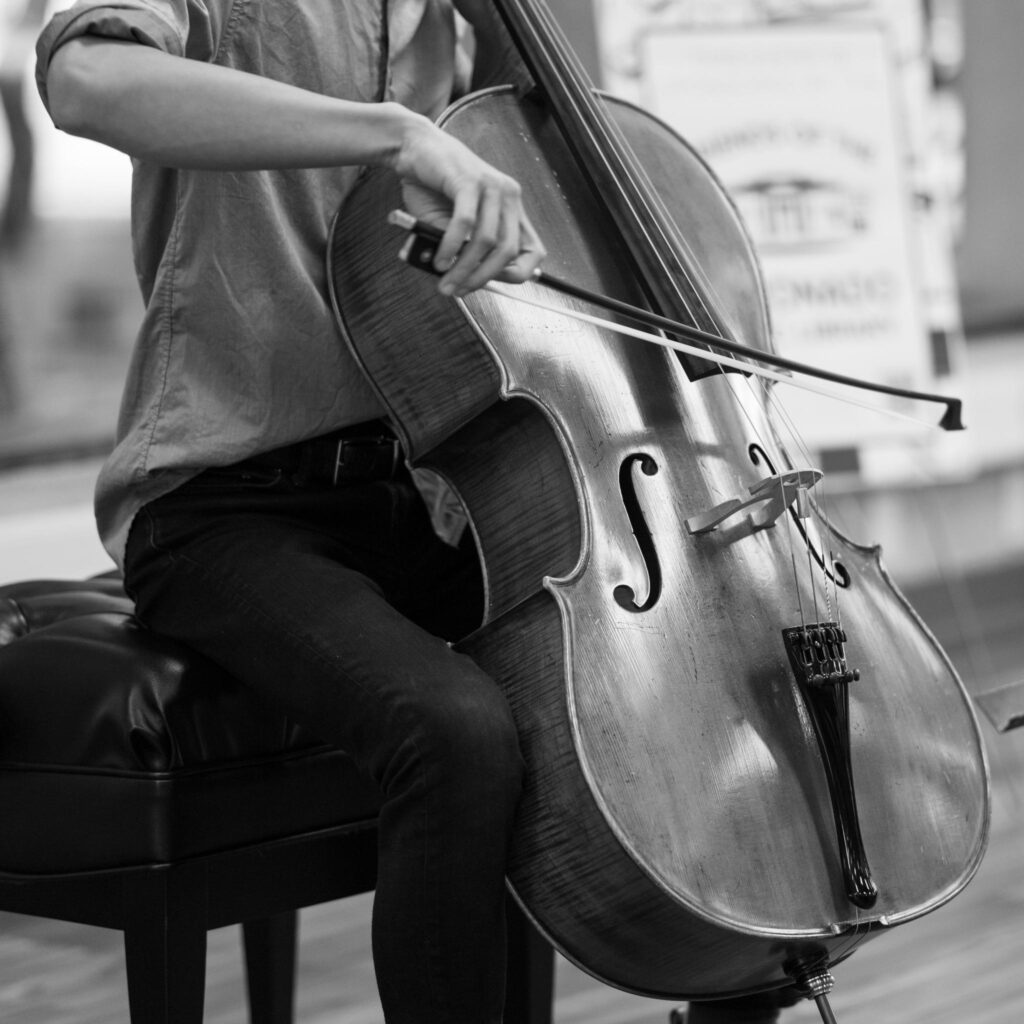
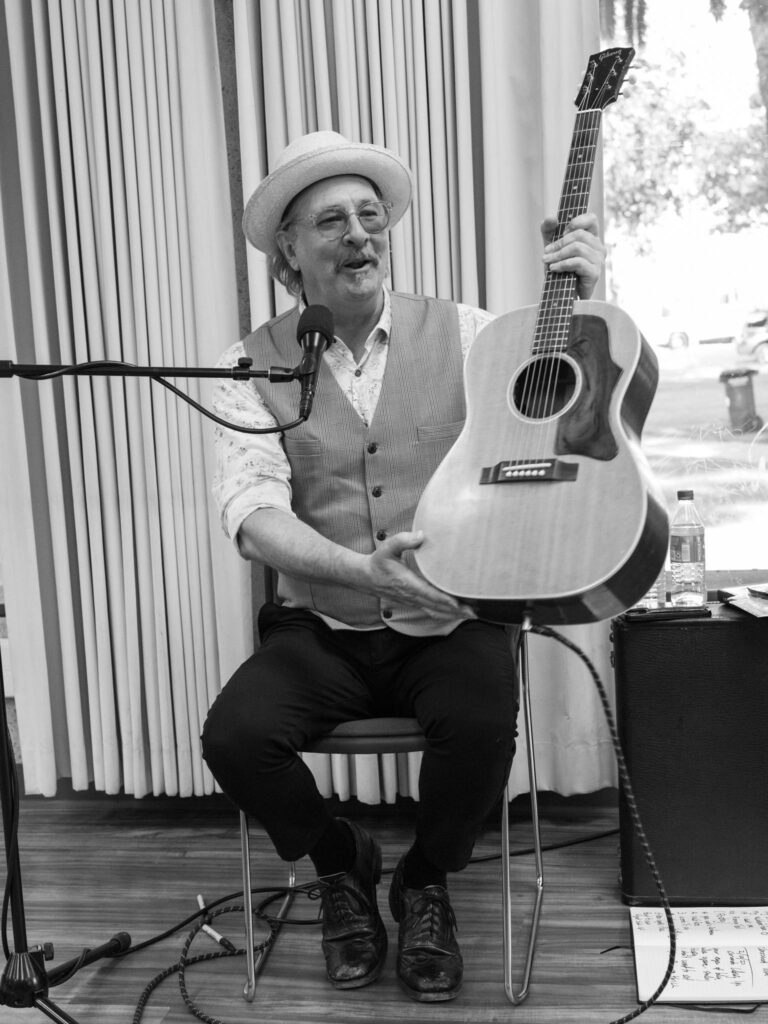
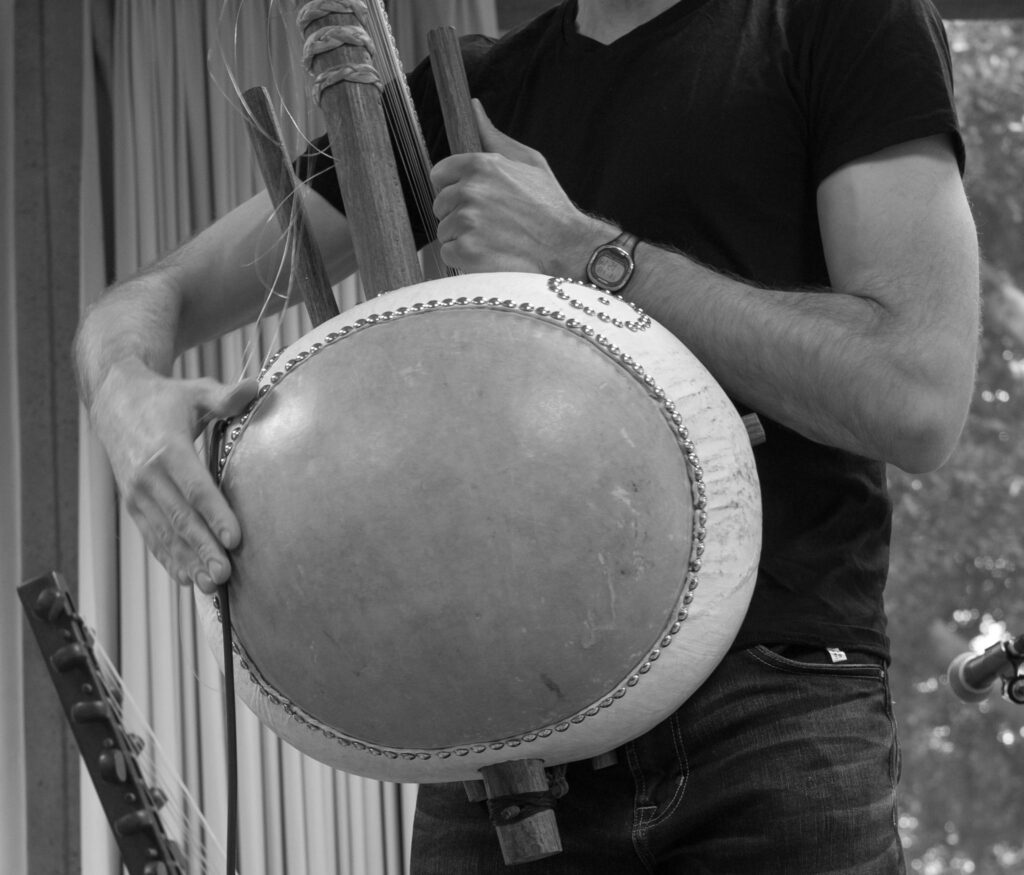
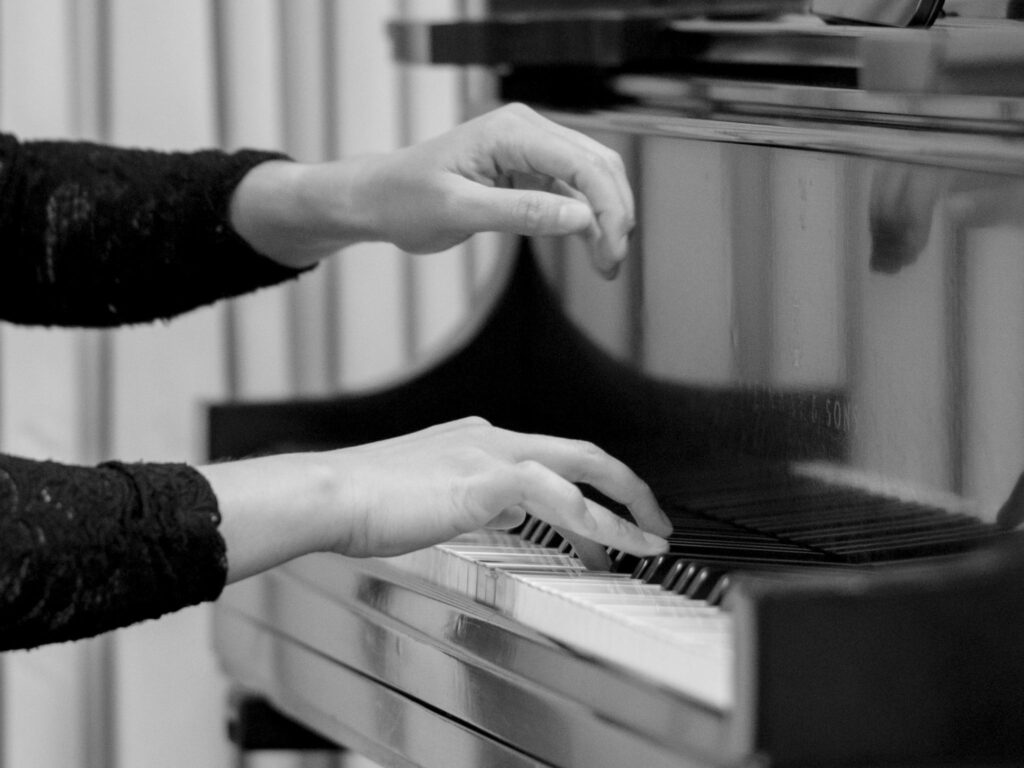
Photographing musicians in the future
Restrictions on bringing more capable cameras to concerts by big-name artists is a significant impediment. I wish I could use a longer focal length lens for close-up shots when unable to stand near the stage. At one concert, the security team would not even allow me to bring in my Q2. They considered it a serious, professional piece of kit, rather than the modest, point-and-shoot number you and I know. I grudgingly handed it over, to be locked in a secure room for the duration of the concert.
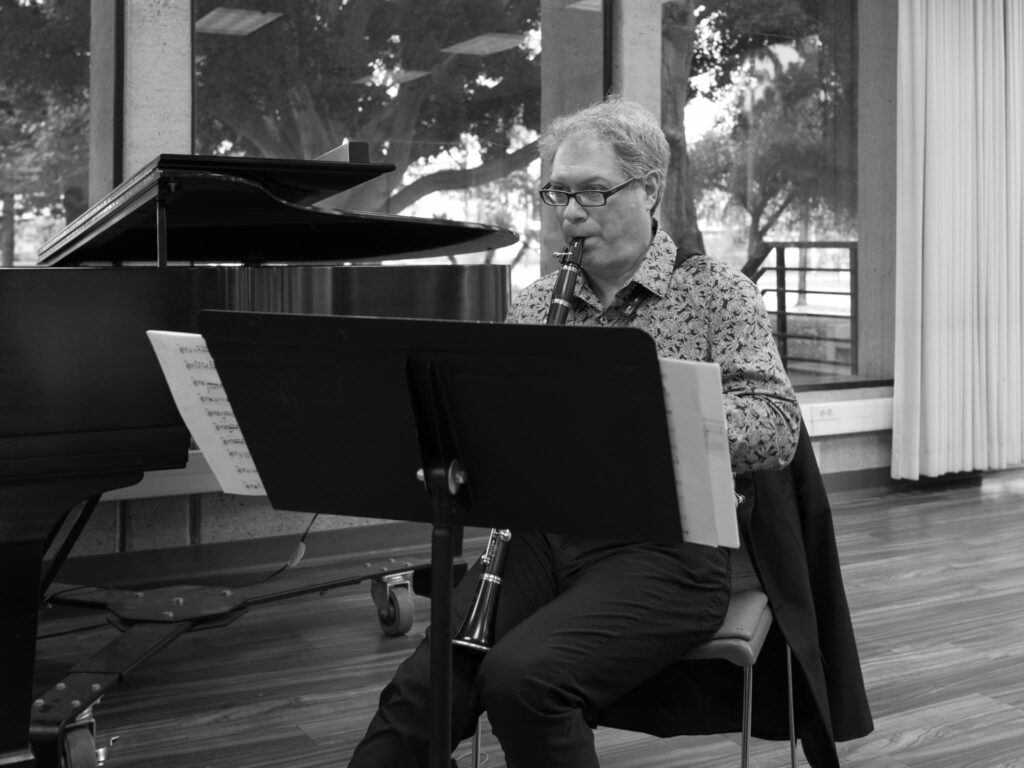
I suppose I need to work on securing some kind of professional photographer accreditation. Until then, I always have that unimpeded view at my local library, provided I can diplomatically wrestle a front row seat from some runny-nosed music student.

Do you have any experience of photographing musicians? Which musical genres offer the best opportunity for the amateur photographer? What sort of gear works well for you? Who is the most famous artist you have photographed in concert? I would love to read your thoughts in the comments section.
Read more from Keith James
Make a donation to help with our running costs
Did you know that Macfilos is run by five photography enthusiasts based in the UK, USA and Europe? We cover all the substantial costs of running the site, and we do not carry advertising because it spoils readers’ enjoyment. Every amount, however small, will be appreciated, and we will write to acknowledge your generosity.

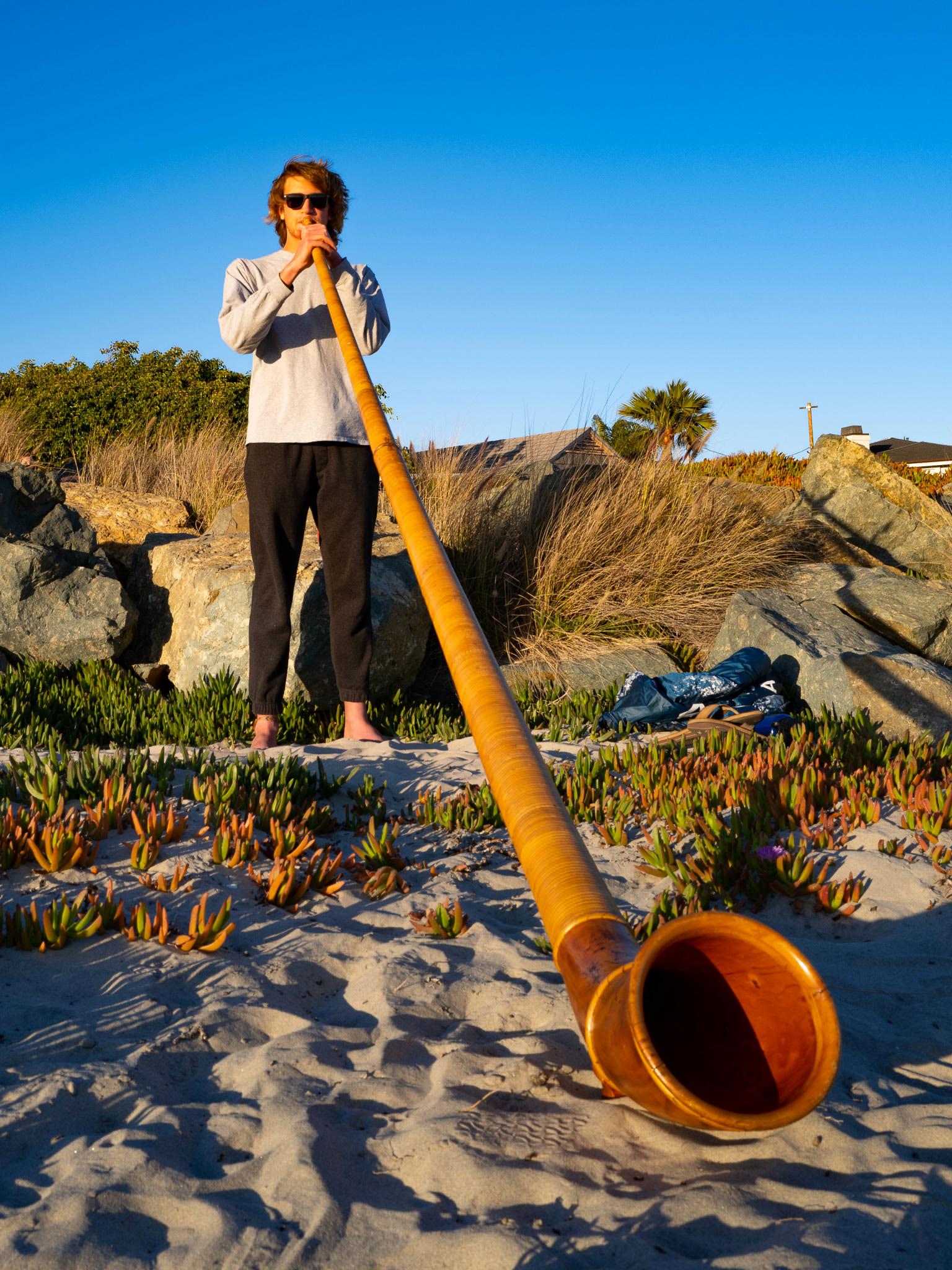
Thank you. Keith, for this article. I can see how much dedication and knowledge is in it. The older I get the more I feel how important it is to know about the things you are photographing (and vice versa, how tremendously photography can help you to understand new things, thus being a means of knowledge or Erkenntnismittel as we would say in German). You obviously have a real interest in music and that makes your images special. I, for example, have no interest infootball and therefore regularly fail in shooting in the pitch. JP
Hi Joerg-Peter, many thanks for commenting. I agree with you that it’s a two way street – knowing more about a subject helps one take better photographs and wanting to take better photographs of a subject is a great motivator for learning more about it. I have learned so much through researching articles for Macfilos. Studying motivated by photographic interests is also great fun! Cheers, Keith
I also like concert photography when I can get away with it. Many Perth venues have a “no professional cameras” rule whatever that means. In these circumstances I’ve found the Leica Dlux Type 109 works very well. The fast lens, zoom ability, spot metering to avoid big shifts in exposure, and the reasonably decent M4/3 sensor for high ISO and best of all it fits in a jacket pocket, or loose jeans at a stretch to avoid the scrutiny of security staff trying to interpret what a professional camera looks like. I had security man turn me away from a venue with an M7 loaded with Tri-X film which may have qualified as a professional camera in the 1990s, but hardly 2015.
Hi Tom, thanks for your comment. I understand musicians, as well as their agents and promoters, feel the need to control how that are depicted photographically, hence restricting telephoto lenses at concert venues. But, they do not control smartphones, which can take great photos as long as you are close to the stage. I will keep trying to smuggle in my Q2 though! All the best, Keith
WHEN ASKED WHAT HIS FAVORITE SONGS WERE GENERAL U S GRANT SAID, I only know two,one is YANKEE DOODLE DANDY, the other isn’t! that’s me with Music if it’s not Jerry Lee Lewis, I don’t ow it! Love the pics thanks!
Most interesting photo essay Keith. The ‘Pump it Up’ panel, the two Kris Lesley alphorn pix, and The Tower Of Power image demonstrate the Q2’s remarkable versatility. I prefer the f1.7 full aperture alphorn photo as the OOF background emphasises the horn bell and its power – I can imagine the sound better and appreciate its long travel. I once tried to photograph the late Jacques Loussier in concert at Peterborough Cathedral but was prevented from getting close with my M6 & 50/1.4 loaded with the original Agfa Scala slide film – but subsequently ‘sneaked’ a couple of pix after the concert when he signed the CD I purchased. He was a remarkable pianist and his weekend bag allegedly contained just a clean black shirt and a toothbrush!
Hi Dunk, thanks! I hadn’t thought of the Jacques Loussier Trio for a very long time, but when I read your comment, I immediately pictured him and his very distinctive beard, where all the action was below his lower lip. I am glad you appreciated the photos from the Q2. It really is something special. It can cover so many situations and in each case deliver a superb image. I have come to the view that if I only owned one camera, it would be a Q2. All the best! Keith
Hi Kathy, thanks so much! It was fun putting this compilation together; the photos were probably taken over the course of a year.
I do not feel the same unease about photographing a musician in performance, as I do a stranger on the street. I tell myself that they have made an explicit choice to place themselves in the public eye, and that it comes with their celebrity status – even if their performance is taking place on the street, or at a local library! Thanks again for reading and commenting. Cheers, Keith
Wow! What a wonderful collection of photos. The range of subjects and venues is just amazing.
Though you describe yourself as being more comfortable with more abstract subjects, in looking through the photos I felt many captured exactly the human moment: triumph, sadness, focus. . .
I’d say it deserves a standing ovation 🙂